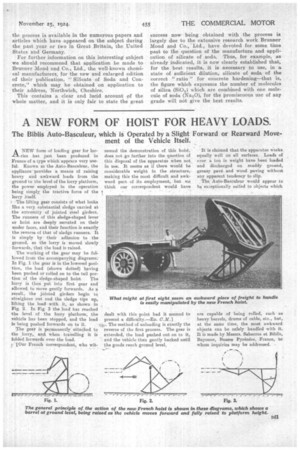HARDENING CONCRETE ROADS.
Page 24

Page 25

If you've noticed an error in this article please click here to report it so we can fix it.
An Interesting New Publication on the Silicate of Soda Process, Showing Its Value also for the Treatment of Garage Floors.
TN-1T1EW of the continued rapid growth in the -Luse of commercial motor ' vehicles, due to the obvious advantages, in competition with the railways, of cheapness, speed and convenience, it is becoming imperative that the problems of road construction shall be solved on scientific lines. There is no need to emphasize the fact that most of the roads of to-day were never intended to withstand modern traffic conditions, or that, for many reasons, the future may lie with concrete. For example, roads constructed with this material can be made of any weight and thickness, with exactly the right camber and be much stronger at the gutters, whilst the cost is less, and most of the
material is found either on the site itself or in the immediate neighbourhood. Further, a concrete surface Can be rendered still harder and more impervious to water and to oil by a simple and inexpensive treatment with silicate of soda. This process is of the greatest interest to all motor users.
Silicate of soda is manufactured by fusing together a good quality of sand (silica SiOG) with soda ash (NaG COG), the resulting glass-like product being usually dissolved in water under special conditions and sold as a colourless solution. Various grades are supplied, depending on the proportions used of the two constituents, and when the right product is diluted to a sufficient extent with water and applied to a clean and dry concrete surface, the result is the formation of a dense and hard outer layer, which is much more resistant than the untreated concrete to abrasion, impact, cutting, scraping and slicing actions, and every other factor which may be included under the general term "wear and tear," so that the value of the pro
B4b cess from the point of view of the heavy motor vehicle will be obvious. At the same time, the permeability to water and to oil is reduced in a very pronounced degree—obviously of great interest in connection with garage floors, to take one example. The method of applying the treatment is quite simple, consisting merely in dissolving one part of the commercial silicate of soda solution in four parts of water, spraying this over the surface, which, as already indicated, must be clean and dry, and then allowing it to lie for 24 hours. The process is carried out three times in succession, and, in addition to simplicity, has the merit of cheapness, cost ing less than per square yard for the three coats, whilst dusting is eliminated and the appearance and texture
of the concrete are net altered, nor is the surface rendered slippery— a very important point for concrete roads. The effect lasts at least 12 months, and can easily be renewed as required.
With regard to the chemical reactions involvedin the treatment, the silicate of soda solution penetrates the pores of the concrete to a depth of Ili. to in. and combines with the free hydrated lime present (originally liberated in the setting of the cement) to give calcium silicates. At the same time, free silica (SiOG) is separated, and the carbon dioxide of the atmosphere also combines with the lime to give calcium carbonate on the same general lines as the setting cf mortar. The net result is that all the pores are completely filled up with an intensely hard silicious binding material, and ample evidence as to the practical value of the process is available in the numerous papers and articles which have appeared on the subject during the past year or two in Great Britain, the United States and Germany.
For further information on this interesting subject we should recommend that application be made to Brunner Mond and Co., Ltd., the well-known chemical manufacturers, for the new and enlarged edition of their publication, "Silicate of Soda and Concrete," which may be obtained on application to their address, Northwieh, Cheshire.
This contains a clear and lucid account of the whole matter, and it is only fair to state the great success now being obtained with the process is largely due to the extensive research work Brunner Mond and Co., Ltd., have devoted for some time past to the question of the manufacture and application of silicate of soda. Thus, for example, as already indicated, it is now clearly established that, for the best results, it is necessary to use, in a. state of sufficient dilution, silicate of soda of the correct " ratio " for concrete hardening—that is, the figure which expresses the number of molecules of silica (Si02) which are combined with one molecule of soda (Na00), for the promiscuous use of any grade will not give the best results.


































